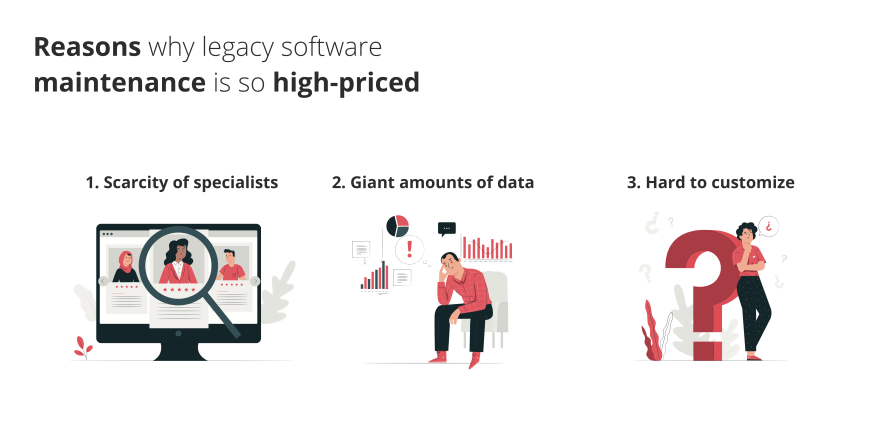The number of enterprises using legacy software is still inexcusably large, one of the recent surveys proved that about 86% of enterprises are still utilizing at least one outdated tool. For some it may seem not big of a problem - just replace the legacy system with a modern one. However, this is a very costly solution - companies will have to spend tons of money just to transfer data accurately without losing anything in the process.
Are there any other less risky options? Maintaining a legacy system might appear as a more attractive alternative, however, it also costs almost no less than replacing the system with a new one.
Let’s find out why is it so expensive to support legacy software.
- Scarcity of specialists
Technologies don’t stand still, they are constantly evolving. Some technologies of the past, the names of which are probably familiar to retired engineers only, are not in demand anymore since there are 10 times more progressive modern technologies these days. It’s almost impossible to find a person available specializing on a decent level in technologies like C, Cobol, Assembly, Perl or Delphi today. And if you find one, it will cost you a lot, and you’ll have to spend tons of time while searching for them.
- Giant amounts of data
Enterprises that exist for more than 10 years on the market have accumulated dozens and hundreds of terabytes of data using the legacy systems. Just imagine how much do these amounts of data cost? The more outdated the used technologies are, the higher the risk level will become and the more expensive it will be to ensure data safety.
- Hard to customize
There is always a need for new features and while it is easy to implement them when the software application is modern and progressive, it will be a burden to do so with a legacy system. The thing is that outdated technologies are somewhat limited and therefore you can’t really do anything you want with them. Customizations will be extremely exhausting to implement, time-consuming, pricey and risky - a new feature might break some others.
How to minimize costs and risks when supporting a legacy system?
Smartym Pro has always been opting for modernizing legacy systems and software maintenance cost reduction step-by-step. One of the best solutions we always offer to our clients is code refactoring. Code refactoring is about optimizing the legacy code piece by piece in order to make the whole system more effective, make it work faster and make the solution progressive and future-proof in general.
It is a long-term process that requires scrupulous work, however, the result of such accurate work will make a reliable base for further system modernization works. Regular code refactoring reduces the probability for the system to become legacy, eliminates interoperability issues and cuts down on the number of bugs and errors. As a bonus, code refactoring makes the system process the operations faster and improves user experience.
Another thing that Smartym Pro offers as a part of their app modernization services - servers architecture review and/or total system audit. It helps define the pain spots and bottlenecks of the current solution as well as the opportunities for system modernization. As a result of the review - together with the client we come up with the most preferable solution in the given situation that will guarantee a good price/quality ratio. Application audit and architecture review is one of the most significant steps to creating a stable and reliable system.
Migration to the Cloud is one of the popular options we offer. As a rule, this service includes infrastructure and database migration as well as post-migration support and consulting. Usually, we recommend Cloud migration for the systems that have already been refactored and/or audited. In a nutshell, it is better to migrate to the Cloud when the data of the legacy system is accurately structured, otherwise, you risk treating the symptoms instead of curing the disease. A system with a bad code, especially an outdated one, will still remain the same even after being migrated to Cloud.
Migration to Cloud is not the only cost-saving solution for a legacy system. If you’re using an out-of-box CMS - it can be transferred to JAM Stack, monolith architecture system - changed to microservices, cross-platform mobile applications - changed to native.
If you make the right decision together with a team of professionals that will help you analyze your specific situation and pick the technological solution suitable for your case, you won’t have to worry ever again about high maintenance costs. Moreover, once the system is made future-proof and easy to support, you won’t have to hire a full-time maintenance team anymore which makes a great deal in cutting down on costs.
Conclusion
Hundreds of enterprises suffer from exhausting amounts of money they have to spend in order to keep a legacy 20-year-old system afloat. The more you postpone the decision to ask for an advice of a professional team to help you pick the optimal software modernization solution, the more expensive your legacy system maintenance will be.
Make the first step now, and soon you will see how many opportunities you have been missing. We are sure that your employees using your legacy software now will be very glad after all. High-quality software that demonstrates fast work and great performance is also one of the aspects influencing your employees’ motivation. Think about it.








Top comments (0)